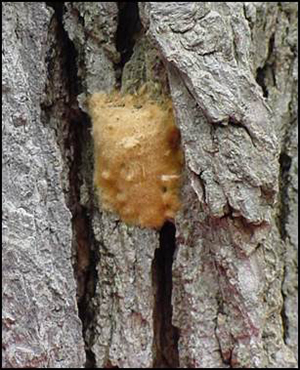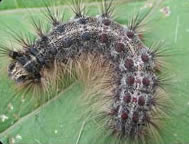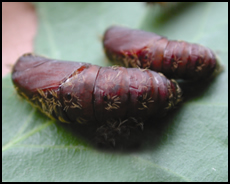Scientific name: Amphimallon majale Razoumowsky (Syn.
It is still rare to find spongy moth in Minnesota, usually the only way they are detected is when lured into survey traps. Other species more commonly found in Minnesota, such as the Forest and Eastern Tent Caterpillars, can be similar-looking to spongy moth.
It is still rare to find spongy moth in Minnesota, usually the only way they are detected is when lured into survey traps. Other species more commonly found in Minnesota, such as the Forest and Eastern Tent Caterpillars, can be similar-looking to spongy moth.
Spongy moth eggs are laid in a fuzzy, tan-colored mass. The egg mass contains 500-1,000 eggs and is about the size of a quarter. Eggs are laid during late summer and hatch the following spring. Egg masses can be found on both living and inanimate objects, including:
- nursery stock
- logs
- roof eaves
- wheel wells
- firewood
- lawn chairs
 Egg mass
Egg mass
This is the life stage that is most likely to be transported by humans.
Spongy moth eggs are laid in a fuzzy, tan-colored mass. The egg mass contains 500-1,000 eggs and is about the size of a quarter. Eggs are laid during late summer and hatch the following spring. Egg masses can be found on both living and inanimate objects, including:
- nursery stock
- logs
- roof eaves
- wheel wells
- firewood
- lawn chairs
 Egg mass
Egg mass
This is the life stage that is most likely to be transported by humans.
The caterpillar hatches from the egg and grows to a length of 2½ inches as it matures. Its body is covered with hairs to protect it from predators. Along its back, the caterpillar has five pairs of blue spots near the head followed by six pairs of red spots. It actively feeds on plant foliage from late spring through mid-summer.
 Caterpillar (larva)
Caterpillar (larva)The caterpillar hatches from the egg and grows to a length of 2½ inches as it matures. Its body is covered with hairs to protect it from predators. Along its back, the caterpillar has five pairs of blue spots near the head followed by six pairs of red spots. It actively feeds on plant foliage from late spring through mid-summer.
 Caterpillar (larva)
Caterpillar (larva)The pupa is an immobile stage of this insect's life. Though it appears inactive, it is very busy inside transforming from a caterpillar into an adult moth. Found during mid-summer, it is dark reddish-brown, leathery in appearance, and often tethered to an object with silk strands. Pupae can range in size from ¾ inch to 1½ inches long.
 Pupa
Pupa

